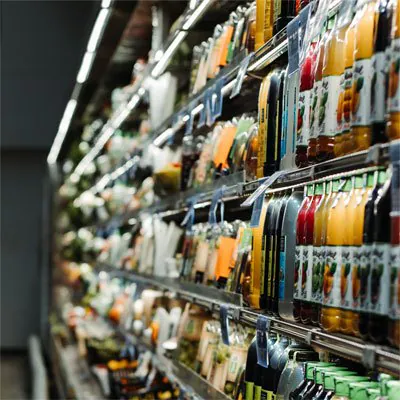Reliable information on the product shelf life is essential for consumer protection. The duty of care lies with the manufacturers – but the consumers must also change their awareness.
Food packaging contains a lot of information. The list of ingredients, possible allergens, information about the manufacturer, weight or quantity and the corresponding expiration dates all contribute to consumer protection. Manufacturers meet the legal requirements for food labeling by providing information on the shelf life of food. They thus comply with national and international food hygiene regulations – and inform consumers about how long a product will remain of high quality and safe for consumption.
But what exactly do notices such as “Best before” or “Use by” actually mean? Which processes do manufacturers use to determine the shelf life of their products and does expired food really have to be disposed of immediately? The following article provides important facts about the topic of food shelf life.
1. Best-before Date vs. Use-by Date
Most foodstuffs on the market such as yoghurt, butter, juices or grated cheese have a so-called best-before date (MHD). It states the date up to which the product will retain its specific properties such as taste, smell or color if stored properly. The best-before date is a guarantee from the manufacturer: the quality of a product remains unchanged until the relevant date is reached. If the specified minimum durability can only be guaranteed under certain temperatures or other conditions, a corresponding note must be attached. After the best-before date, most foods can still be consumed without hesitation – as long as they are unobtrusive in terms of smell and taste.
Easily perishable foods such as fresh meat or fish products as well as cream cheese or ready-made salads must be marked with a use-by date. This states the date up to which the product can be consumed if stored properly and refrigerated. After the use-by date, consumption of these products may pose microbiological risks to human health. The food may then no longer be sold or should no longer be used by consumers. The use-by date, in contrast to the best-before date, is crucial for food safety. The manufacturers guarantee the risk-free consumption of their products – if the cold chain is maintained accordingly.
Foodstuffs that have a very short shelf life, such as bread or fresh fruit and vegetables, as well as products that have a long shelf life, such as vinegar or sugar, do not require an expiration date. Consumers can decide for themselves by when they want to consume the food.
2. This is how the shelf life of products is determined
The shelf life of a food depends on various factors such as the composition, the degree of processing and the packaging and storage conditions. Since the manufacturers know the properties of their products best, it is their responsibility to determine the best-before or use-by date with the help of appropriate test procedures. While large companies often carry out the tests to determine the shelf life internally, smaller companies in particular are dependent on external service laboratories such as Biolytix. The quality of the products is evaluated in the laboratory and it is determined under practical conditions with storage or stability tests whether a foodstuff meets the shelf life specifications.
In the storage test, a product is stored for a defined period of time and under defined conditions. Its characteristics – color, taste and texture – are regularly examined. For example, if a food is to last 90 days at refrigerated temperatures, it is stored accordingly in the laboratory. Samples are taken both at the beginning and at various times during the shelf life. Storage tests allow manufacturers to assess how their product will perform over time.
A stability test is a more comprehensive test. Other factors are also considered that can influence the shelf life – such as humidity or strong temperature fluctuations. The product is stored under different conditions to determine how its properties behave over time. The stability tests enable manufacturers to specify optimal storage conditions and shelf-life recommendations on their packaging.
3. The shelf-life labeling of food is becoming more and more challenging
The implementation of comprehensive storage and stability tests is becoming increasingly important as part of the manufacturer’s duty of care. For example, the demand for natural products with a high degree of freshness is increasing. At the same time, the delivery areas are expanding, the transport routes are becoming longer – with strongly fluctuating climatic conditions. Short-term changes in recipes due to a lack of raw materials also pose a challenge for manufacturers. The demands on the quality and shelf life of food are increasing. Microbiological special laboratories such as Biolytix analyze products and ingredients with regard to possible quality changes along the entire value chain. With the help of the latest analysis methods, the shelf life of products is determined and solutions for extending the shelf life are examined.
4. Food shelf life and food waste are related
Manufacturers must both meet consumer expectations and guarantee that they are bringing safe food to market. To be on the safe side, manufacturers often mark their products with a use-by date, although a best-before date would be sufficient. The result: a lot of food that could still be eaten ends up in the garbage. But consumers are also often unsure about the best-before date. Most of them are based on the best-before date. Once this has expired, the products are disposed of. In total, almost three million tons of food are thrown away in Switzerland every year. These include numerous products for which the best-before date has expired but which would still have been edible. According to a study from 2019, around one million tons of food are thrown away in Swiss private households every year – partly because consumers lack knowledge about storage and shelf life. Improved consumer awareness and changes in manufacturers’ dating behavior could help curb food waste. For example, a specialist group at the Zurich University of Applied Sciences has drawn up two guidelines with specific recommendations for action. The goal: to optimize the dating of food and counteract unnecessary waste. In addition to recommendations for freezing products on the use-by date, it also contains suggestions for the appropriate dating type depending on the food category.
The consideration of appropriate recommendations for action and simultaneous cooperation with laboratories for comprehensive shelf-life analysis as well as heightened consumer awareness can make a decisive contribution to minimizing food waste in the future. – A goal that now also has a high priority on the agenda of the Federal Council. The aim of the action plan against food waste is to halve avoidable food losses in Switzerland by 2030.




